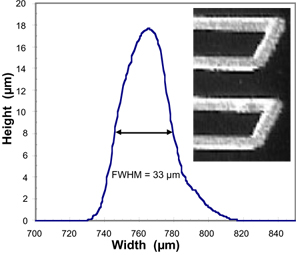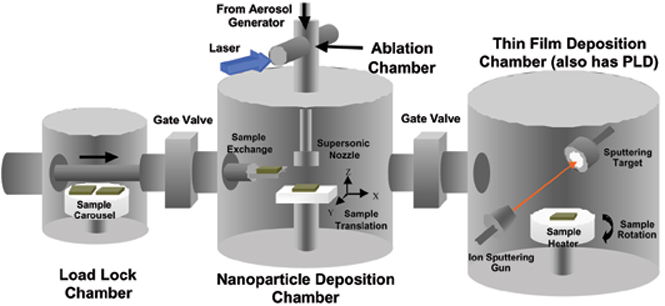Laser Spectroscopy and
Nanoparticle Research
at The University of Texas in Austin
Nanoparticle Research
at The University of Texas in Austin

Nanoparticle Deposition - Direct Write
We have designed, constructed, and tested an apparatus, shown in the figure below, to produce nanocomposites consisting of Nanoparticles (NPs) embedded in thin films. In this UHV apparatus, NPs are first formed from microparticles of the same composition using the LAM process, as described in the LAM section. The NPs will then expanded through a supersonic jet and impact onto a substrate sitting on a computer controlled sample stage maneuvered just below the nozzle at a distance of 5-20 nozzle-diameters. Following deposition of the NPs onto the substrate at low coverage densities (< one monolayer), the sample will be moved to a second chamber where the NPs will be covered by growing (near epitaxially) a film over and around them.
A key element to producing nanocomposite films is that the NPs are required to retain their size and shape after impaction onto the substrate. For a given substrate and NP type, the kinetic energy per atom at impact determines their fate. Simulations indicate that clusters with energy much less than 1 eV per atom show little deformation on impact while abovethis energy, significant deformation occurs. By controlling the gas type in the LAM cell, the nozzle diameter and shape, and nozzle-to-substrate distance, the impact energy can be adjusted to achieve either soft impaction with little deformation (<< 1 eV/atom) or hard impaction (~1 eV/atom) to make self-sintered films.
For encapsulation, we have investigated many possible deposition techniques. Thin crystalline AlN films have been epitaxially grown by MOCVD (Metal-organic Chemical Vapor Deposition), MBE (Molecular Beam Epitaxy), PLD (Pulsed Laser Deposition), and MS (Magnetron Sputtering). The commonly used crystalline substrates in these studies were Si, sapphire, and SiC.
To date, most of the deposited AlN thin films were hexagonal with a highly textured orientation of (0001) on crystalline substrates. AlN films produced by MBE or CVD showed high purity and bulk-like crystalline properties; MS and PLD also lead to c-axis-oriented films. Comparing these techniques, MBE and CVD can be used to produce films of very good crystalline quality, but deposition rates are comparatively low. The substrate temperature of CVD is higher (1000-1100ºC) than those of PLD and MS. MS requires a high nitrogen background pressure that leads to a larger surface roughness. PLD has the advantages of low temperature growth (AlN epitaxial layers have been grown by PLD at temperatures from 750 to 800ºC), higher deposition rate, less contamination by impurities, and nearly stoichiometric composition of the films. Dual ion beam sputtering is a unique technique that can be used to produce very smooth films. It has the advantage of controlling each deposition parameter (substrate temperature, ion species through N2/Ar flow ratio, and ion energy) separately.
An alternative method of encapsulation and film deposition can use the LAM process itself. Such two-component layered films can be manufactured using a two-nozzle ablation cell. The nozzles are arranged one behind the other in the path of the laser so that two independent aerosols can be ablated simultaneously. Since the flows are at atmospheric pressure and laminar, they mix slowly by diffusion. The NP aerosol then flows into either two supersonic jets or into a single laminar jet. If the substrate motion is along the line connecting the two nozzles, successive layers of the two NPs can be deposited simultaneously. If the number density of the first NP aerosol is less than that of the second, a composite can be formed where the first NPs are imbedded in a matrix of the second. Conversely, if the motion is orthogonal to the line connecting the nozzles, separate, adjacent lines of the two pure NPs can be written on the surface. Isolation of the NPs can be maintained at higher coverage densities by capping them to produce shelled particles. We have succeeded in capping semiconductor nanoparticles with hydrogen by ablating the particles in a He/H2 aerosol. The thickness of the deposited NP layers can be adjusted by varying the sample velocity under the jet and by varying the density of microparticles from the aerosol generator. By varying these parameters, we have written films with a wide range of thicknesses from sparse, with a few nanoparticles per µm2, to those that are dense and several µm thick.
 Periodic structures of nanocomposites need
to be written onto substrates for many applications. In some cases,
these structures should extend into the third dimension by using
multiple layers. For example, the coherent interaction of these
periodic
structures with applied magnetic or electromagnetic fields can
greatly increase device performance. To demonstrate nanostructure
manufacturing, we have already utilized the supersonic-jet deposition
technique to direct write self-sintered conductive lines of Ag NPs. The
figure left shows a directly written serpentine pattern of silver on
glass. The line width of 33 µm FWHM was written with a supersonic
jet orifice 200 µm in diameter. It is evident from the narrower
line width that the flat-plate orifice acts to focus the heavier NPs in
the center of the gas jet. Similar large area films have been produced
using the same method with WC, PZT, and Terfenol-D, and they were
adherent (passing the Scotch tape test). With our current
laboratory-scale LAM apparatus, we can produce a 10 mm by 10 mm
nanocomposite film that is 10 µm thick in less than 30 minutes.
Periodic structures of nanocomposites need
to be written onto substrates for many applications. In some cases,
these structures should extend into the third dimension by using
multiple layers. For example, the coherent interaction of these
periodic
structures with applied magnetic or electromagnetic fields can
greatly increase device performance. To demonstrate nanostructure
manufacturing, we have already utilized the supersonic-jet deposition
technique to direct write self-sintered conductive lines of Ag NPs. The
figure left shows a directly written serpentine pattern of silver on
glass. The line width of 33 µm FWHM was written with a supersonic
jet orifice 200 µm in diameter. It is evident from the narrower
line width that the flat-plate orifice acts to focus the heavier NPs in
the center of the gas jet. Similar large area films have been produced
using the same method with WC, PZT, and Terfenol-D, and they were
adherent (passing the Scotch tape test). With our current
laboratory-scale LAM apparatus, we can produce a 10 mm by 10 mm
nanocomposite film that is 10 µm thick in less than 30 minutes.We believe that a significant narrowing of the linewidth observed in the figure can be achieved by using smaller supersonic nozzles; nozzles as small as 20 µm have been reported in the literature. Since the aerosol focusing effect is self-similar (the NP beam is 1/6 of the nozzle diameter), we may obtain linewidths as small as 4 µm by using smaller nozzles.
